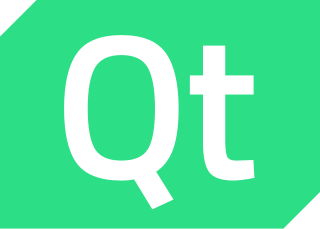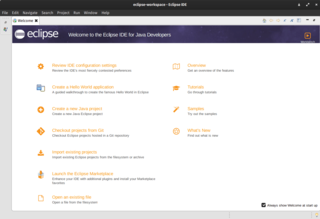Related Research Articles

Qt is cross-platform software for creating graphical user interfaces as well as cross-platform applications that run on various software and hardware platforms such as Linux, Windows, macOS, Android or embedded systems with little or no change in the underlying codebase while still being a native application with native capabilities and speed.

Eclipse is an integrated development environment (IDE) used in computer programming. It contains a base workspace and an extensible plug-in system for customizing the environment. It is the second-most-popular IDE for Java development, and, until 2016, was the most popular. Eclipse is written mostly in Java and its primary use is for developing Java applications, but it may also be used to develop applications in other programming languages via plug-ins, including Ada, ABAP, C, C++, C#, Clojure, COBOL, D, Erlang, Fortran, Groovy, Haskell, JavaScript, Julia, Lasso, Lua, NATURAL, Perl, PHP, Prolog, Python, R, Ruby, Rust, Scala, and Scheme. It can also be used to develop documents with LaTeX and packages for the software Mathematica. Development environments include the Eclipse Java development tools (JDT) for Java and Scala, Eclipse CDT for C/C++, and Eclipse PDT for PHP, among others.
Microsoft Blend for Visual Studio is a user interface design tool developed and sold by Microsoft for creating graphical interfaces for web and desktop applications that blend the features of these two types of applications. It is an interactive, WYSIWYG front-end for designing XAML-based interfaces for Windows Presentation Foundation, Silverlight and UWP applications. It was one of the applications in the Microsoft Expression Studio suite before that suite was discontinued.

Apache Flex, formerly Adobe Flex, is a software development kit (SDK) for the development and deployment of cross-platform rich web applications based on the Adobe Flash platform. Initially developed by Macromedia and then acquired by Adobe Systems, Adobe donated Flex to the Apache Software Foundation in 2011 and it was promoted to a top-level project in December 2012.

A graphical user interface builder, also known as GUI designer or sometimes RAD IDE, is a software development tool that simplifies the creation of GUIs by allowing the designer to arrange graphical control elements using a drag-and-drop WYSIWYG editor. Without a GUI builder, a GUI must be built by manually specifying each widget's parameters in the source code, with no visual feedback until the program is run. Such tools are usually called the term RAD IDE.

A website wireframe, also known as a page schematic or screen blueprint, is a visual guide that represents the skeletal framework of a website. The term wireframe is taken from other fields that use a skeletal framework to represent 3 dimensional shape and volume. Wireframes are created for the purpose of arranging elements to best accomplish a particular purpose. The purpose is usually driven by a business objective and a creative idea. The wireframe depicts the page layout or arrangement of the website's content, including interface elements and navigational systems, and how they work together. The wireframe usually lacks typographic style, color, or graphics, since the main focus lies in functionality, behavior, and priority of content. In other words, it focuses on what a screen does, not what it looks like. Wireframes can be pencil drawings or sketches on a whiteboard, or they can be produced by means of a broad array of free or commercial software applications. Wireframes are generally created by business analysts, user experience designers, developers, visual designers, and by those with expertise in interaction design, information architecture and user research.
A software widget is a relatively simple and easy-to-use software application or component made for one or more different software platforms.
Justinmind is a prototyping and wireframing tool for the creation of high-fidelity prototypes of web and mobile apps. It’s known for its ability to render realistic versions of a finished product as well offering collaboration, interaction and design features. Overall, it’s grown into one of the most popular prototyping tools in the industry.
ooVoo was a video chat and a messaging app developed by ooVoo LLC and owned by Krush Technologies, LLC. ooVoo had applications for Android, iOS, Mac OS X, Microsoft Windows, Windows Phone, and Facebook. The original Microsoft Windows app was released in 2007. It was discontinued on November 25, 2017.

The Pidoco Usability Suite is a cloud-based collaboration software created by Pidoco GmbH for creating, sharing and testing wireframes, mockups, prototypes of websites, mobile apps, and enterprise software applications.
Balsamiq Studios is an ISV founded in March 2008 by Peldi Guilizzoni, a former Adobe senior software engineer. The Web-based Balsamiq mockup tool was launched in June 2008. Balsamiq has 33 employees based in San Francisco, Sacramento, Chicago, Bologna, Paris, and Bremen. In 2011, Balsamiq achieved almost US$5 million in sales, and US$6.4 million in 2015.
Fluid UI is a browser-based wireframing and prototyping tool developed by Fluid Software and used to design mobile touch interfaces.
Proto.io is an application prototyping platform launched in 2011 and developed by PROTOIO Inc. Originally designed to prototype on mobile devices, Proto.io has expanded to allow users to prototype apps for anything with a screen interface, including Smart TVs, digital camera interfaces, cars, airplanes, and gaming consoles. Proto.io utilizes a drag and drop user interface (UI) and does not require coding.
Codename One is an open-source cross-platform framework aiming to provide write once, run anywhere code for various mobile and desktop operating systems. It was created by the co-founders of the Lightweight User Interface Toolkit (LWUIT) project, Chen Fishbein and Shai Almog, and was first announced on January 13, 2012. It was described at the time by the authors as "a cross-device platform that allows you to write your code once in Java and have it work on all devices specifically: iPhone/iPad, Android, Blackberry, Windows Phone 7 and 8, J2ME devices, Windows Desktop, Mac OS, and Web. The biggest goals for the project are ease of use/RAD, deep integration with the native platform and speed."

Appcelerator is a privately held mobile technology company based in San Jose, California. Its main products are Titanium, an open-source software development kit for cross-platform mobile development, and the Appcelerator Platform.

2X Software was a Maltese software company specializing in virtual desktop, application virtualization, application delivery, Remote Desktop Services, remote access and Mobile Device Management. On 25 February 2015, 2X Software was acquired by Parallels, Inc. The 2X products, Remote Application Server and Mobile Device Management, are now included in Parallels' offering.

B4X is a suite of rapid application development IDEs and proprietary programming language that allows the creation of applications on the following platforms: Google Android, Apple iOS, Java, Raspberry Pi and Arduino. Although the B4X syntax is very similar to BASIC, it is an entirely new language.
Flutter is an open-source UI software development kit created by Google. It is used to develop cross platform applications from a single codebase for any web browser, Fuchsia, Android, iOS, Linux, macOS, and Windows. First described in 2015, Flutter was released in May 2017.
References
- ↑ "WireframeSketcher About Page".
- ↑ "WireframeSketcher Joins Eclipse Foundation". PRWeb. 2013-02-05.
- ↑ "WireframeSketcher Eclipse Solutions Member". Eclipse Foundation . Retrieved 2013-05-21.
- ↑ Erez Zuckerman (2011-09-15). "WireframeSketcher". PC World.
- ↑ Juhani Lehtimaki (2012-04-11). "WireframeSketcher Android ICS Stencils Updated".
- ↑ "Eclipse Community Awards Winners Announced". Eclipse Foundation. 2011-03-21.
- ↑ "Eclipse Community Awards Announced 2013". Eclipse Foundation. 2013-03-26.
- ↑ "Eclipse Community Awards Winners Announced". H-Online. 2013-03-26.